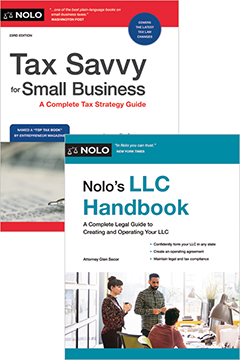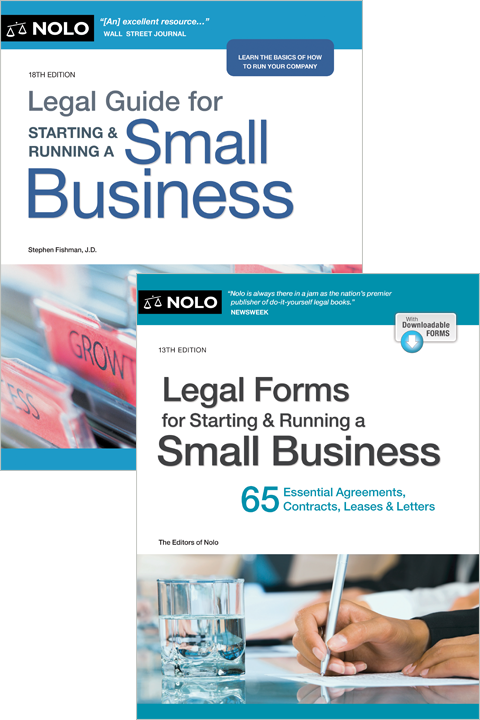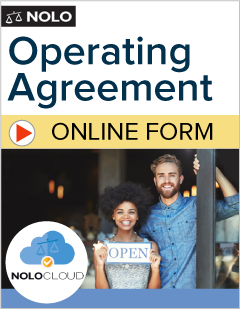Don't neglect to write a business prenup before putting money into a venture. Before things get messy, decide when a co-owner can or must leave, who can buy their share, and how much that share is worth.
At some point, after you embark on a business venture with other people, someone's bound to make their exit. While that reality might seem far away, it's important to address this possibility before your business opens its doors.
You and your co-owners should draft a buy-sell agreement—also known as a "buyout agreement"—to lay out the rules and procedures to follow when one or more owners leave.
Why Do You Need a Buy-Sell Agreement?
A buyout agreement protects business owners when a co-owner wants or has to leave the company and protects the owner who's leaving. If a co-owner leaves, a buyout agreement acts as a sort of "premarital agreement" to protect everyone's interests—setting the price and terms for a buyout.
Every day that value is added to a business without a plan for future transition, the owners' financial risk increases. An agreement will reduce uncertainty and can help avoid uncomfortable negotiations between the owner who leaves and the owners who remain.
Additionally, if a company doesn't have a buy-sell agreement in place, it's at the mercy of its state's laws. Your state's laws might not correspond with the future you or the other owners see for your business. For instance, some states require a partnership to dissolve when a partner leaves. If you don't want the default rules of your state to decide your business's fate, you'll need an agreement that says what'll happen.
What Is a Buy-Sell Agreement?
A buy-sell agreement can be either a separate agreement or a section within a company's governing document. This agreement is a legally binding contract among a business's owners that provides the rules and procedures for:
- when an owner can or must leave
- who can buy the departing owner's share of the business
- how much the departing owner's share of the business is worth, and
- what happens to the business after the owner leaves.
Let's take a closer look at each of these buyout agreement topics.
When an Owner Can or Must Leave
Broadly speaking, there are two situations in which an owner will leave a company. Either the owner will voluntarily leave or be forced out—either by the other owners or by outside circumstances.
An owner might decide to leave for different reasons such as:
- wanting to retire
- wanting to pursue other business interests
- not getting along with the other owners
- receiving an outside offer for their share, or
- not seeing the business as profitable or worth pursuing anymore.
Typically, a buy-sell agreement will provide rules for how and when the owner must provide notice of their intent to leave to the other owners. Everyone will hopefully walk away relatively pleased.
But sometimes an exit is a little messier—particularly when the owner is being forced to leave the company. A buy-sell agreement usually lists circumstances that will "trigger" a forced buyout that requires an owner to give up their share of the business.
These circumstances usually include:
- an owner dying or becoming incapacitated
- an owner filing for bankruptcy
- a secured creditor claiming an owner's share, and
- an owner entering a divorce settlement that gives their ex-spouse an interest in the company.
When an owner is forced to give up their ownership in the company, they might put up a fight. Having a buy-sell agreement that clearly lists out the circumstances that require an owner to surrender their interest can help eliminate much of the back-and-forth between the owners.
Who Can Buy the Departing Owner's Share of the Business
In addition to covering the circumstances under which an owner can or must leave the company, your buy-sell agreement should address who can buy the departing owner's interest.
Generally, you have three options for who can buy the departing owner's share:
- the other business owners
- the business itself, or
- a non-owner.
Your agreement should specify who can or must buy the business. Many companies will require the departing owner to first offer their interest to the other owners or to the company in what's known as the "right of first refusal." Then, if the other owners or the company decide not to purchase the interest, the departing owner can offer their share to someone outside of the company.
When creating a buy-sell agreement, you and your co-owners should decide which option would work best for you. With larger companies (particularly corporations with shareholders), it might not be as important to require owners to offer their share back to the company or other owners. With smaller companies where the owners are actively running the business together—like partnerships and limited liability companies (LLCs)—it often makes sense to require the departing owner to offer their share to the other owners.
If you require the departing owner to offer their company share back to the other owners or to the business, you should specify whether the other owners or the company have to buy it. Requiring the other owners or the business to buy the share simplifies and speeds up the buyout process. On the other hand, not requiring the purchase can open the business and its owners to outside business opportunities.
How Much the Departing Owner's Share Is Worth
An owner is leaving the business and you've established who can purchase their share. But how do you determine how much money should the departing owner get for their share?
It can be hard to settle on a price in a buy-sell agreement before your business has even gotten off the ground. You probably don't know how successful the business will be or what its true value is.
Fortunately, you don't have to put a specific value on the price of an owner's share if you don't want to. Instead, your buyout agreement can state that the value of an owner's share will depend on the company's value.
Usually, the price for an owner's share is determined by:
- the business's current value (if it were liquidated)
- the business's equity or "book value"—that is, its value after subtracting its liabilities from its assets, or
- the present value of a future flow of distributions or dividends.
Once you put a price on the business's value, you can calculate the departing owner's buyout share. Usually, the departing owner will receive an amount proportional to their ownership share. For example, if a business is valued at $100,000 and the departing owner owns 30% of the business, they'd probably receive $30,000 for their share.
But an owner's buyout can depend on other factors that the owners have agreed to. For instance, sometimes an owner's distribution (profit) share doesn't equal their ownership interest. Likewise, an owner's buyout price doesn't have to match their ownership interest.
What Happens to the Business After an Owner Leaves
When an owner leaves, what becomes of the company? Generally, there are two outcomes: the company ends (dissolves) or continues. While the answer might be obvious to some, it's still worth spelling out in the buy-sell agreement.
Usually, whether the business should end or continue after an owner departs depends on the company's business structure. For corporations and LLCs, the company usually continues on without the owner or with a new owner in their place. LLCs and corporations are more resilient to ownership changes. With their limited liability and flexible management structures, it's usually not hard to find an immediate or eventual replacement owner.
For example, suppose Buzz, Woody, and Andy own the LLC, Pizza Planet, LLC. For the pizza joint, Buzz develops the recipes, Woody takes care of the marketing, and Andy handles the accounting. One day, Andy decides to retire and sells his share of the company back to Woody. Instead of the company ending, Buzz and Woody can hire an accountant to take over Andy's responsibilities and business can go on as usual.
But for general and limited partnerships (and limited liability partnerships), a partner's withdrawal can mean the end of the company. Some partnerships require their company to wind up and dissolve if a general partner exits because a general partner's role in the business is so critical to the business's operations.
For instance, returning to our Pizza Planet example, now suppose Buzz is a general partner and Woody and Andy are limited partners who don't help run the business. Buzz decides to retire. Because Buzz made the pizza and managed the staff—and was the face of the restaurant—it'd be difficult for Woody and Andy to carry on the business without him.
If you don't include what happens to your business when an owner exits, your state's laws will step in to provide the answer. Be sure to include this determination to avoid your business prematurely ending.
What Are the Types of Buy-Sell Agreements?
Buyout agreements can be for any business with more than one owner. The main types of buy-sell agreements are:
- shareholder buyout agreements (for corporations)
- LLC owner buyout agreements, and
- partnership buyout agreements (for general, limited, and limited liability partnerships).
While these buyout agreements all contain many of the same elements, they can differ in their rules and procedures. For example, a shareholder buyout agreement might provide a different method for determining a share's value than a partnership buyout agreement. Or different events might trigger an LLC owner buyout than a shareholder buyout.
As mentioned earlier, a buy-sell agreement might actually appear as a provision within the company's governing document. If you want to take this route, business owners often put a buyout provision in one of the following documents:
- for a corporation, the shareholder's agreement, bylaws, or articles of incorporation
- for an LLC, the operating agreement or articles of organization, and
- for a partnership, the partnership agreement.
Buy-Sell Agreement FAQ
As you're negotiating your buy-sell agreement with your co-owners and considering the potential issues that might crop up down the road, you might have a few questions.
If a co-owner of a business divorces, can the former spouse ask for part ownership in the business?
In some states, yes, and the former spouse can succeed in getting it, too. In community property states, all earnings during marriage and all property acquired with those earnings are considered community property—owned equally by husband and wife. When property is divided during a divorce, each spouse can claim a right to all community property. So, if the owner's business share is considered community property, their former spouse might have a claim on it.
Even in non-community property states, a spouse could argue for a partial interest in the business, because marital property laws generally require property to be divided equitably during divorce.
To avoid this prospect, a good buy-sell agreement requires the former spouse of a divorced owner to sell any interest received in a divorce settlement back to the company or the other co-owners. The ex-spouse will usually be compensated based on the valuation method specified in the agreement.
Can a co-owner's personal bankruptcy affect the business?
Potentially. In the worst-case scenario, a bankruptcy trustee, who's appointed to oversee and manage the bankruptcy, could liquidate the business (sell its assets) to pay the bankrupt owner's debts. However, usually, a trustee can usually only sell the entire business if it's structured as a partnership and the trustee has the court's permission. Otherwise, typically only your share of the business is at stake.
Regardless of your business structure, to head off the possibility of your company getting tied up in bankruptcy court, the owners can sign a buy-sell agreement that requires a co-owner who faces bankruptcy to notify other co-owners before filing. Usually, under the terms of this agreement, the owner filing for bankruptcy must sell their interest in the company back to the other owners before they file. After severing ties with the owner, the business can proceed.
What happens if a company needs to, but can't afford to, buy out one of its owners?
Requiring an immediate 100% lump-sum cash payout can prevent even the most successful company from buying back a departing owner's interest. Having flexible payment terms built into a buy-sell agreement, created in advance, can help.
For instance, the agreement can provide for a down payment of 20% to 30% of the buyout price. The remaining amount can be paid out in installment payments for three to five years at a reasonable rate of interest defined or specified in the agreement.
Separately, it's common for a company or its owners to take out life insurance policies on each owner. Assume the co-owners of a business have taken this step, naming either the business or its owners as the beneficiaries of the policies. If one owner dies, their share of the business passes to their heir or estate. But the company gets life insurance proceeds that it can use to purchase the deceased owner's company share. Again, the procedure for this type of buyout would need to be included in the buy-sell agreement.
Can a buy-sell agreement be used to avoid estate taxes?
In the past, family or intergenerational businesses (like family LLCs) sometimes successfully used buy-sell agreements to lower (or altogether avoid) estate taxes when an owner died. An intergenerational business is one where at least one co-owner plans to leave their interest to heirs who will remain active in the business.
The key to this estate planning strategy was to choose a conservative price or valuation formula for the business in the buy-sell agreement. The IRS then used that relatively low valuation when calculating whether federal estate tax was due, and how much.
But for buy-sell agreements entered into or modified on October 9, 1990 or later, the rules are more stringent. For example:
- the valuation can't be a way to transfer property to family "for less than full and adequate consideration," and
- the terms of the buy-sell agreement must be "comparable to similar arrangements entered into … in an arms' length transaction" (where the parties aren't related and act in their own self-interests).
(26 U.S.C. § 2703.)
In other words, there's no longer as much leeway in valuing the family business to avoid estate tax.
Fortunately, not many people need to worry about federal estate tax. In 2023, only estates worth more than $12.92 million ($25.84 million for married couples) will trigger the federal estate tax. (In 2026, if no further legislation is passed, this threshold amount is set to essentially halve, but it's still a fairly high threshold for most Americans.) Some states also impose separate state estate taxes at a lower threshold, but the tax rate is much lower than the federal estate tax.
If it seems likely that you'll owe estate tax when you die, consult a business attorney who's experienced with estate tax. And if you already have a buy-sell agreement dated before October 9, 1990, think twice and consult an attorney before modifying it, since you risk losing some of the valuation leeway that still applies to these older agreements.
Can the buy-sell agreement be modified?
Yes. You should have a short sentence in your agreement that says the agreement can be changed by a written amendment with the owners' approval. As your business grows or new owners join, you might notice issues or opportunities you missed before. You'll want to have an agreement that you can reasonably change to reflect these new discoveries.
For example, suppose the ROFR clause in your agreement doesn't apply when an owner dies, meaning a deceased owner's heirs can join your company as owners. One of your co-owners dies and leaves their interest to their nephew who immediately starts making poor management decisions, putting the business into serious debt. You might want to alter your agreement to have the ROFR clause extended to the owners' estates so you can avoid this kind of situation in the future.
Consulting a Small Business Lawyer
If you're starting a business and you're looking to create a buy-sell agreement, talk to your co-owners. You'll need to sit down with them and discuss the terms of the agreement. In all likelihood, this conversation will be much friendlier now than when someone leaves. If you and the other owners are on the same page about most or all of the buyout terms and you have some experience writing legal agreements, you can probably draft a buy-sell agreement yourself.
If you're interested in further guidance and in a buy-sell agreement that you can fill in, check out Business Buyout Agreements: Plan Now for All Types of Business Transactions, by Bethany Laurence & Anthony Mancuso (Nolo).
If the owners are in disagreement or you're not sure which terms are best for your particular situation, you should consult a small business attorney. They can help you negotiate terms with your other owners and draft an agreement for you. They can also advise you on the potential tax implications of your buyout agreement and suggest alternative terms to the ones you're considering.



